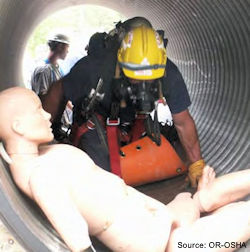Confined Space Rescues
Introduction
Two-thirds of all confined space fatalities occur among would-be rescuers. It is critical to use good confined space entry practices to prevent deaths so there is no need for rescue operations. Remember, even a well-planned rescue can end up as a body retrieval. Rescues can be performed by any employee or a professional rescuer so long as they have been fully trained and qualified to act as rescuers. Qualifications include knowledge of and experience working with all hazards associated with rescue and confined space entry operations.
Before a Rescue Attempt
At a minimum, employers and workers should treat all confined spaces as hazardous. Before entering a confined space to attempt a rescue, a person trained in the proper use of a calibrated, direct-reading instrument must also test for oxygen content, flammable gases and vapors, and potential toxic air contaminants in a confined space. You should never trust your senses to determine if the air in a confined space is safe. You cannot see or smell many toxic gases and vapors, nor can you determine if sufficient oxygen is present.
Knowledge Check Choose the best answer for the question.
3-1. Before entering a confined space to attempt a rescue, a person must _____.
You forgot to answer the question!

